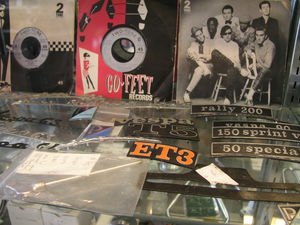Kings Classic Scooter Rally
Much is said here on the MO news posts about the sportbike v. cruiser schism that has affected our culture, but did you know about the plastic v. metal controversy in the scooter world?
There are legions of fans devoted to the vintage steel-bodied scooter, especially those built in Italy between the 1940's and 1980's. They have steel chassis, manual transmissions and clutches, and smokey, noisy, ring-a-ding-ding two-stroke motors.
The main events in the social calendars of the scootisti are a series of rallies held around the country. The big one is held in San Francisco in mid-August. "King's Classic." The big rally sees hundreds of scooters descend on the City from all over California and the world to participate in group rides, parties, contests and other events.
Not so Barry Gwin's cluttered and chaotic scooter shop/museum of scooteralia. The small space in San Francisco's industrial South of Market (SOMA) neighborhood is crowded with scooters, scooter parts, helmets, gear and display cases filled with books, scooter memorabilia, Barbie dolls riding scooters and a really impressive collection of Star Wars action figures. You wouldn't expect such quaintness in an urbane city filled with 800,000 sophisticated consumers, but vintage scooter riders are different.
Gwin has his shop to make a living for his family, but if he "suddenly got millions and millions of dollars" he'd still do the same thing every day. His personal collection contains 40 scooters and he's always looking to add more. As we talk, he's hungrily eyeing a 1949 Vespa a customer dropped off for service, drooling over the stock hand-beaten aluminum headlight shell and chrome handlebar. "I've been trying to buy this bike for a while." Is he able to find time to ride all these scooters? "I make it a point to ride them all, as much as I can."
His shop is as much a club house and museum as it is a working business. "We like to have a scene; a hang-out" he tells me, after he spends 20 minutes telling a potential customer the best way to get her new Vespa ET4 repaired after a car knocked it over. Barry shows no reaction at all when the woman tells him she'll go and shop around to see what the other shops say about her estimate. Never in the two hours I spent at his shop did I see any money change hands.
He tells me scooter sales slow down at the end of the summer, as the current year's inventory disappears and the new scooters don't arrive until later. Unlike the 80's, vintage scooters are rare and expensive. A man calls from England to buy Barry's exquisetley restored and painted 1965 Lambretta 200SX. With shipping, the white and orange bike will be over $10,000. Who is spending money on vintage scooters?
"It used to be everybody we sold [vintage] scooters to was under 25. Now they're all bald and 40 years old. They aren't necessarily rich guys, but people who know what they want and who have done their homework. They want a good, reliable scooter that's a good investment." Does the aging of his clientele make him worry about the future?
On the other extreme is "Twist-n-Go", a mainland China-built machine with plastic bodywork and automatic transmission. Barry views these as disposable, "a new scooter is better than no scooter at all." The profit margins are decent on these bikes, and once a person is used to two-wheel travel, they might want to move upwards and onwards to something more "authentic": "It's easier to flip you onto a vintage Lambretta if you've already got a scooter." In the old days you would buy a cheap old scooter to ride until you could afford a new bike; now you buy a cheap new scooter to ride until you gain the expertise -- or capital -- to buy your real dream bike.
I ask him if he gets nervous seeing novice riders wobble out into traffic on their first scooter from his shop. "Every time I sell a scooter, I take the customer out and teach them how to ride. I'll spend up to three hours with a customer, although most of them only take five minutes." That's the kind of individual attention that sets a shop like Barry's apart from the moto-mega-marts that make up the majority of motorcycle shops in our country. He also treats his employees well: "My average mechanic has been here for five or more years. We keep them by paying a competitive wage and having a fun place to work."
"The motorcycle scene is cool, but not as personal or friendly. The scooter community is a more friendly community. Because first and foremost, our scooters are our friends."
I spent an afternoon riding around San Francisco on a 1974 Vespa, and it was a blast. I wouldn't recommend doing it a lot: breathing two-stroke exhaust from 300 scooters is probably the equivalent of smoking a carton of unfiltered Winstons, but the sound of all those two-strokes and whining transmissions was truly a mechanical symphony.
The big ride I went on wound all over the City and quickly turned into a disorganized melee as scooters jockeyed for position, crossing the double yellow line, passing six abreast, speeding up to pass slow moving cars, even jumping sidewalks and curbs. 300 growling motorcycles would have prompted a wave of 911 calls; with 300 cute scooters, even old ladies smiled and waved at the disorganized cacophony rolling by, a huge grey cloud in its wake.
The destination was out in San Francisco's Bayview district, at a divey nightclub. A trailer was there with a dynamometer so people could measure horsepower, and inside the large building the nicest scoots were displayed in a concourse de' elegance. The bar and DJ were setting up, promising fun and music late into the night as all kinds of scooter fans were able to meet, greet and mingle.
As a motorjournalist, I get to ride the latest and hottest machines from every factory. But most of the bikes on the road aren't the latest and greatest. In fact, most of them are pretty ordinary, machines to get you around. Meet the Vespa, the motorcycle world's equivalent of a 1970 Dodge Dart, except Italian.
Unlike a lot of European exotica, a Vespa scooter is low-performance, basic transportation, designed to be durable, reliable and purely functional. The first ones were designed by Piaggio's aircraft engineers after WWII, so they had no idea how to design a motorcycle. That resulted in some odd design choices that seem inexplicable to us modern techno-heads.
For instance, the engine concentrates its weight on the right, which makes the scooter feel heavy on that side. The steering head angle is practically straight up and down, which gives an incredible turning radius but makes high-speed turns interesting. Teeny front and rear drum brakes will stop the scooter, eventually. The two-stroke motor uses a very low-tech design that gets you maybe 5,000 RPM and eight HP from 150cc.
But all that low-tech means long life. Angela Jeter, who does a little illustration work for MO, has owned this gem for about a year, and generously loaned it to me to ride in the rally. I have spent a few thousand miles on Vespa P200s, riding one to New Orleans and back in 1992, but I had never ridden a Vespa older than the Ford presidency for more than a few blocks.
The kickstarter is easy enough to use, once you learn the drill. It has a short throw and a low-compression piston, and a well-tuned scooter usually fires first or second kick. Angela is very cute and knows mechanics; her scooter is tuned like Dale Earnhardt, Jr's lawnmower. Vroom!
Pull in the surprisingly heavy clutch and rotate the left handgrip clockwise: clunk! The scoot pops into gear with great drama because of the lack of synchromesh in the transmission. Release the clutch, and then pow! It stalls immediately. Vespas have a snatchy clutch.
After you restart, a more careful launch sends you into traffic. The Super pulls away pretty well, quickly winding out to redline. A quick, jerky shift, and then another one, and you are rocketing along at 45 MPH, weaving in and out of traffic because the brakes are mostly ornamental.
Steering is beyond quick. "Telepathic"? No, that implies some thought. "Lightning fast"? Even lightning takes some time to hit the ground. "Precognitive" might describe how these things steer. But you don't feel you're not in control. Well, maybe a little.
Hills are no problem, thanks to the short gearing, but the four-speed ratio, tuned for a max of 60 MPH, means you are in too high a gear in first on a steep hill, but in too tall a gear for second. So 15-20 MPH is the speed you go, enjoying the weird, symphony of oddly muffled two-stroke motor and the whining of straight gears.
It's not loud enough to distract from who-knows-how-old shocks and tires that look like they're from a mover's dolly. Rolling over anything as large as an abandoned Tic-Tac results in bouncing on the aftermarket bench seat. The tires chirp on downshifts. Luckily the brakes aren't strong enough to make the tires slide, although wet pavement and slippery train tracks make you consider renting a car.
You can still pick up running vintage scooters for cheap. Avoid a basket case unless you are sure you can fix it, and by no means, under any circumstances are you to purchase the overpriced shiny garbage from Vietnam and Indonesia being dumped here by some exporters looking to make a fast buck. I've seen plenty of these "classics", and they are almost all horrible: shade-tree hack jobs with home-made parts and cheap paint. They almost always need new motors and electrics, and they usually have been chopped and grafted from two or more scooters, making even the lead-filled and thick-painted bodies worthless.
An ideal Vespa, in my mind, is one like Angela's: original paint faded and scratched by years of actual use by loving owners, the remaining parts settled into a comfortable equilibrium of bare functionality. Thanks, Angela!
I took lots of pictures of the fun and unusual sights and people at the event, complete with captions. There's also some video of the swarm of scooters attacking Delores street. I learned that vintage scooters are a great way to have fun and meet people on two wheels without a lot of the angry, competitive energy you sometimes encounter at motorcycle events.See you at the next rally!
More by Gabe Ets-Hokin, Editor-at-Large





































Comments
Join the conversation